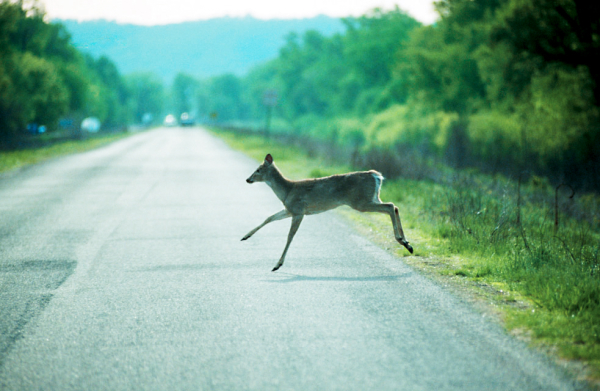Oh, Deer! Use Caution While Driving This Fall
  |
Vehicle accidents with white-tailed deer are common in the fall, and drivers need to be alert to the danger, according to Whitetails Unlimited Executive Director Pete Gerl. “There are hundreds of thousands of accidents with deer nationwide, and the only way to prevent them is for drivers to be alert to the danger,” Gerl said. “Drivers need to be aware that deer are more active in the fall, particularly during the hours around dusk and dawn.”
During the fall and early winter deer need to find extra food sources to survive the winter, and they often find excellent food sources along roads and highways. In addition, Fall is the time of year when deer are engaged in mating, and do not act with their normal level of caution. Deer are primarily active at night, so dawn and dusk are main travel times as they move from bedding areas to feed in the evening, and back in the morning.
There are a number of things a driver can do to be safer during this time of year:
- If you see one deer, assume there are others around. Deer often travel in groups.
- Deer crossing signs along the highway are there for a reason – deer are known to cross the road in that area. Be extra cautious in these areas.
- Make sure you and your passengers always wear seatbelts.
- Be more cautious while driving at all times. Deer are normally more active between dusk and dawn and are crossing roads during the night, when visibility for drivers is at the lowest.
- Reduce your speed and watch the edges of the road, as well as ditches and tree lines along the highway. At night, drive within the limits of your headlights and use your high beams when you are able to. Headlights will pick up reflections from the deer’s eyes long before you will be able to see the entire deer. If you see these reflections, start to slow down.
- If a collision with a deer is inevitable, avoid swerving to miss the deer, and do not go into the ditch or cross the centerline into oncoming traffic. Most experts advise hitting the deer instead of swerving sharply into the side of the road and possibly loosing control of the vehicle, hitting a roadside object, or rolling the vehicle.
- If you do hit a deer, call 911 if there are injuries or if your vehicle is disabled. Insurance companies normally require a police report if there is damage that needs to be repaired. Do not approach a deer that is injured but still alive. It will be scared and want to flee, and you can be injured by hooves or antlers. Police officers and game wardens are permitted to destroy injured animals, but it is usually not legal for individuals to kill a deer out of season or without a license, regardless of circumstance.
Seeing a deer in the woods is a wonderful treat, but it’s scary when you see one in front of you when you’re driving. Be careful out there.
– END –
About Whitetails Unlimited:
Since our beginning in 1982, Whitetails Unlimited has remained true to its mission and has made great strides in the field of conservation. Thanks to more than 475 chapters, 114,000-plus members, chapter volunteers, and corporate sponsors, Whitetails Unlimited has earned the reputation of being the nation’s premier organization dedicating its resources to the betterment of the white-tailed deer and its environment. Our mission is to raise funds in support of educational programs, wildlife habitat enhancement and acquisition, and preservation of the shooting sports and hunting tradition for future generations. To date, Whitetails Unlimited has expended more than $102.7 million on program services and activities that continue to enhance, and ultimately foster, our mission. Stay connected with us: Facebook, Instagram, Twitter, WTU Website
